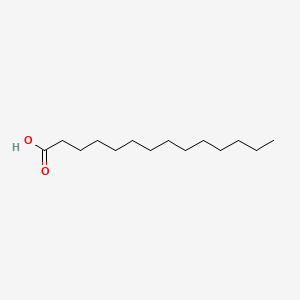| MeSH term | MeSH ID | Detail |
|---|---|---|
| Hemolysis | D006461 | 131 associated lipids |
| Uremia | D014511 | 33 associated lipids |
| Stomach Ulcer | D013276 | 75 associated lipids |
| Diabetes Mellitus | D003920 | 90 associated lipids |
| Sarcoma, Experimental | D012513 | 13 associated lipids |
| Neovascularization, Pathologic | D009389 | 39 associated lipids |
| Breast Neoplasms | D001943 | 24 associated lipids |
| Lung Neoplasms | D008175 | 171 associated lipids |
| Insulinoma | D007340 | 28 associated lipids |
| Colonic Neoplasms | D003110 | 161 associated lipids |
Tetradecanoic acid
Tetradecanoic acid is a lipid of Fatty Acyls (FA) class. Tetradecanoic acid is associated with abnormalities such as Chronic lung disease, Infection, Spastic syndrome, Diabetes and Cardiovascular Diseases. The involved functions are known as Fatty acid biosynthetic process, Anabolism, lung alveolus development, 5-(carboxyamino)imidazole ribonucleotide mutase activity and Homeostasis. Tetradecanoic acid often locates in Structure of parenchyma of lung, Blood, Head, Membrane and Cytoplasmic matrix. The associated genes with Tetradecanoic acid are SLC33A1 gene, SFTPA1 gene, P4HTM gene, Polypeptides and GPR132 gene. The related lipids are Fatty Acids, Nonesterified Fatty Acids, palmitoleic acid, Phosphatidylglycerols and Butanols.
Cross Reference
Introduction
To understand associated biological information of Tetradecanoic acid, we collected biological information of abnormalities, associated pathways, cellular/molecular locations, biological functions, related genes/proteins, lipids and common seen animal/experimental models with organized paragraphs from literatures.
What diseases are associated with Tetradecanoic acid?
Tetradecanoic acid is suspected in Infection, Cardiovascular Diseases, Obesity, Chronic lung disease, Diabetes, Diabetes Mellitus, Non-Insulin-Dependent and other diseases in descending order of the highest number of associated sentences.
Related references are mostly published in these journals:
| Disease | Cross reference | Weighted score | Related literature |
|---|
Possible diseases from mapped MeSH terms on references
We collected disease MeSH terms mapped to the references associated with Tetradecanoic acid
PubChem Associated disorders and diseases
What pathways are associated with Tetradecanoic acid
There are no associated biomedical information in the current reference collection.
PubChem Biomolecular Interactions and Pathways
Link to PubChem Biomolecular Interactions and PathwaysWhat cellular locations are associated with Tetradecanoic acid?
Visualization in cellular structure
Associated locations are in red color. Not associated locations are in black.
Related references are published most in these journals:
| Location | Cross reference | Weighted score | Related literatures |
|---|
What functions are associated with Tetradecanoic acid?
Related references are published most in these journals:
| Function | Cross reference | Weighted score | Related literatures |
|---|
What lipids are associated with Tetradecanoic acid?
Related references are published most in these journals:
| Lipid concept | Cross reference | Weighted score | Related literatures |
|---|
What genes are associated with Tetradecanoic acid?
Related references are published most in these journals:
| Gene | Cross reference | Weighted score | Related literatures |
|---|
What common seen animal models are associated with Tetradecanoic acid?
There are no associated biomedical information in the current reference collection.
NCBI Entrez Crosslinks
All references with Tetradecanoic acid
Download all related citations| Authors | Title | Published | Journal | PubMed Link |
|---|---|---|---|---|
| Resh MD | Fatty acylation of proteins: new insights into membrane targeting of myristoylated and palmitoylated proteins. | 1999 | Biochim. Biophys. Acta | pmid:10446384 |
| Warnotte C et al. | Unbound rather than total concentration and saturation rather than unsaturation determine the potency of fatty acids on insulin secretion. | 1999 | Mol. Cell. Endocrinol. | pmid:10459862 |
| Meek S et al. | Microcystin affinity purification of plant protein phosphatases: PP1C, PP5 and a regulatory A-subunit of PP2A. | 1999 | FEBS Lett. | pmid:10471836 |
| Snook JT et al. | Effect of synthetic triglycerides of myristic, palmitic, and stearic acid on serum lipoprotein metabolism. | 1999 | Eur J Clin Nutr | pmid:10477245 |
| Veuillez F et al. | Synthesis and characterization of an acylated di-peptide (Myr-Trp-Leu) with modified transmucosal transport properties. | 1999 | Eur J Pharm Biopharm | pmid:10477324 |
| Smith JM et al. | Activation of the Abl tyrosine kinase in vivo by Src homology 3 domains from the Src homology 2/Src homology 3 adaptor Nck. | 1999 | J. Biol. Chem. | pmid:10488144 |
| Sliwinski-Korell A et al. | Oligomerization and structural changes of the pore-forming Pseudomonas aeruginosa cytotoxin. | 1999 | Eur. J. Biochem. | pmid:10491177 |
| Niisato N et al. | Effects of PKA inhibitors, H-compounds, on epithelial Na+ channels via PKA-independent mechanisms. | 1999 | Life Sci. | pmid:10499877 |
| Fujii H et al. | The active form of the ferric heme in neutrophil cytochrome b(558) is low-spin in the reconstituted cell-free system in the presence of amphophil. | 1999 | J. Biochem. | pmid:10502679 |
| Timm S et al. | The EF-hand Ca(2+)-binding protein p22 associates with microtubules in an N-myristoylation-dependent manner. | 1999 | Mol. Biol. Cell | pmid:10512881 |
